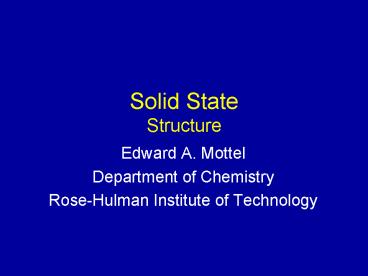Solid State Structure - PowerPoint PPT Presentation
1 / 45
Title:
Solid State Structure
Description:
Solid State. Structure. Edward A. Mottel. Department of Chemistry ... Ionic Solid State Structures. Imperfections and Disorder. controlled valency 1 2 3 ... – PowerPoint PPT presentation
Number of Views:329
Avg rating:3.0/5.0
Title: Solid State Structure
1
Solid StateStructure
- Edward A. Mottel
- Department of Chemistry
- Rose-Hulman Institute of Technology
2
Ionic Solid State Structures
- Many ionic structures are based on
- the larger ion packing very efficiently (cubic or
hexagonal closest pack). - the smaller ion occupying holes in the structure.
- Not every hole is occupied by the smaller ion,
and sometimes whole sheets of hole locations are
vacant.
3
Layered Structures
rock salt
CdCl2
alternate sheets of cations are missing
4
CdCl2 layered structure
5
Ionic Solid State StructuresImperfections and
Disorder
- Above absolute zero, crystals will not be
perfectly packed. - Schottky defects
- F center
- Frenkel defect
6
(No Transcript)
7
Ionic Solid State StructuresImperfections and
Disorder
Schottky defects
8
Ionic Solid State StructuresImperfections and
Disorder
-
F center
Frenkel defect
9
(No Transcript)
10
Ionic Solid State StructuresConductivity
- Solid ionic compounds are poor electrical
conductors. - Mobile charges (ions or electrons) are needed for
electrical conductivity.
11
Ionic Solid State StructuresImperfections and
Disorder
1
2
3
controlled valency
12
Ionic Solid State StructuresMixed Valence
Conductivity
13
Solid State StructuresIonic and Covalent
Character
EN Ca 1.00 Cd 1.69 Hg 2.00
polarization of the cation
polarization of the anion
14
Solid State Bonding
- Ionic bonding
- favors small, hard ions.
- is isotropic (independent of angle).
- follows the radius ratio rule.
- Covalent bonding
- becomes important as atoms become softer (more
polarizable). - is directional (uses specific orbitals for
overlap. - may result in a lower coordination number.
15
Solid State Bonding
- Small differences in electronegativity and
smaller atoms form more covalent bonds.
16
Solid State Bonding
- Small differences in electronegativity and
smaller atoms form more covalent bonds.
less overlap
17
BondingBand Theory
18
BondingBand Theory
for silicon the valence band is full the
conduction band is empty
19
Band Gap
diamond
silicon
germanium
tin
Smaller gap for heavier elements
20
Band Gap
graphite has a different structure than
diamond and is a conductor
diamond - insulator
semimetal, semiconductor
grey tin - metallic, conductor
Smaller gap for heavier elements
21
BondingCovalent and Metallic Bonding
conduction band
Insulator
Metal
22
Density of States
overlapping mos in extended structure
levels are not uniformly spaced
Insulator
Metal
Semiconductor
23
Conductivity
24
Band Gap
free electrons or holes move charge
higher temperature puts more e- in conduction band
25
Elements in Semiconductors
N
O
B
C
F
P
S
Al
Si
Cl
As
Se
Ga
Ge
Zn
Cu
Br
Sb
Te
In
Sn
Cd
Ag
I
Intrinsic Si, Ge, Fe3O4
Alloys GaP, GaAs, ZnS, CdS, CdSe, SiC
26
Doped Semiconductors
conduction band
valence band
27
Diode
n-type
p-type
a combination of an n-type semiconductor and
a p-type semiconductor that allows current
flow in a preferred direction
28
Diode
n-type
p-type
e- flow can occur with e- moving to more
stable energy levels
Both conduct because there are mobile electrons
or holes and locations to move to.
Battery provides e- on one side and drain on
the other side.
e-
e-
-
29
Diode
n-type
p-type
Current flow in the reverse direction requires e-
move to higher energy levels, and occurs only
with large applied potentials (breakdown voltage).
The semiconductors are charge neutral, and
additional charge will build up in the valence
band preventing significant current flow.
e-
e-
30
Diode
Current ?
? Reverse Bias
Forward Bias ?
Applied Voltage
31
Light Emitting Diodes
band gap
wavelength (color)
h 6.62 x 10-34 Jsmolecule-1
c 3.00 x 108 ms-1
32
(No Transcript)
33
Solid State Photoreactions
Ag
Ag
Ag
Br-
Br-
Br-
Ag
Ag
Ag
Br-
Br-
Br-
Ag
Ag
Ag
Br-
Br-
Br-
Ag
Ag
Ag
Br-
Br-
Br-
Ag
Ag
Ag
Br-
Br-
Br-
Ag
Ag
Ag
Br-
Br-
Br-
34
Solid State Photoreactions
Ag
Ag
Ag
Br-
Br-
Br-
Ag
Ag
Ag
Br-
Br-
Br-
Ag
Ag
Ag
Br-
Br
Br-
Ag
Ag
Ag
Br-
Br-
Br-
Ag
Ag
Ag
Br-
Br-
Br-
Ag
Ag
Ag
Br-
Br-
Br-
35
AgBr(s) ? Ag(s) ½ Br2(l)
½ Br2(g)
325 kJmol-1
Ag(g)
Br-(g)
Ag(g)
Ag(l)
Ag(s) Br2(l)
100 kJmol-1
AgBr(s)
major energy requirement is reverse of EA of Br-
36
AgBr(s) ? Ag(s) ½ Br2(l)
E 325,000 Jmol-1
h 6.62 x 10-34 Jsmolecule-1
c 3.00 x 108 ms-1
mol 6.02 x 1023 molecules
(near uv)
37
1-2-3 SuperconductorYBa2Cu3O7
38
Resistivity
metal
superconductor
Tc
39
Superconductivity
40
(No Transcript)
41
Types of Bonds Formed
Lighter members of a family often form multiple
bonds
Heavier members favor additional single bonds.
42
Heavier Members of a Familytend to form single
bonds
43
(No Transcript)
44
Ionic Solid State StructuresImperfections and
Disorder
controlled valency
45
(No Transcript)































